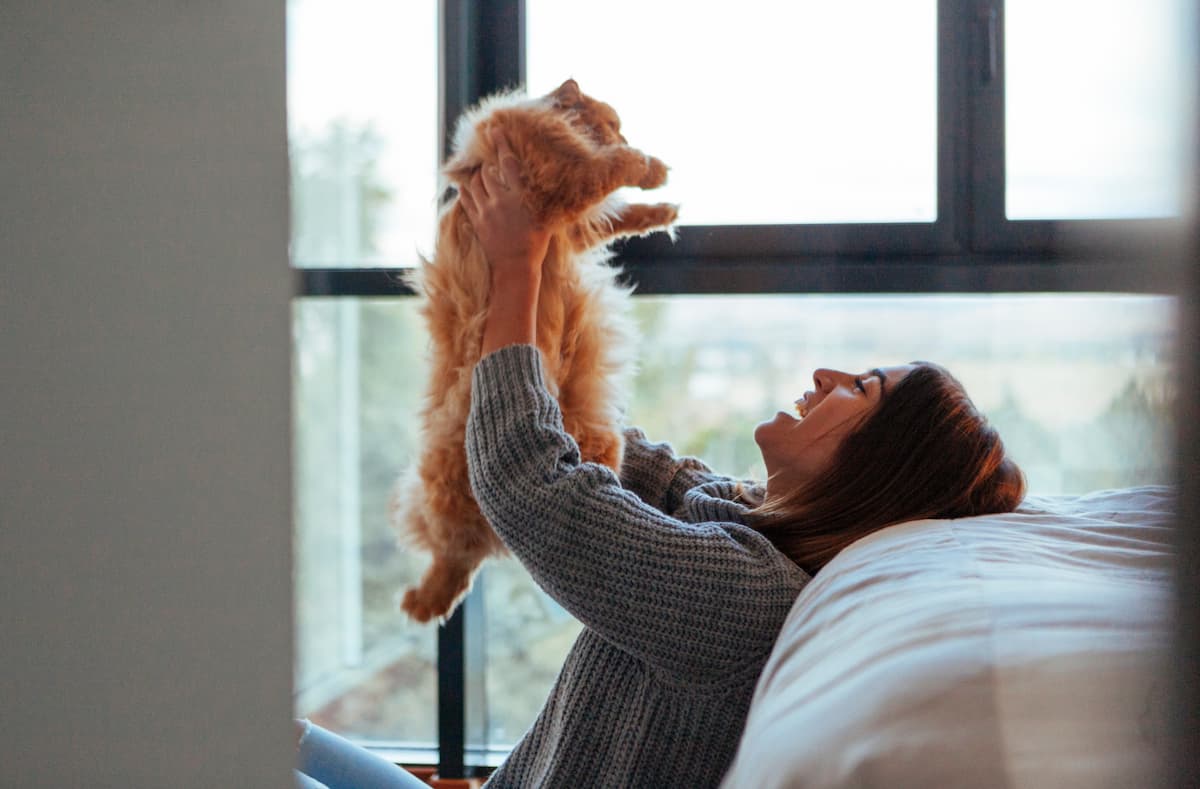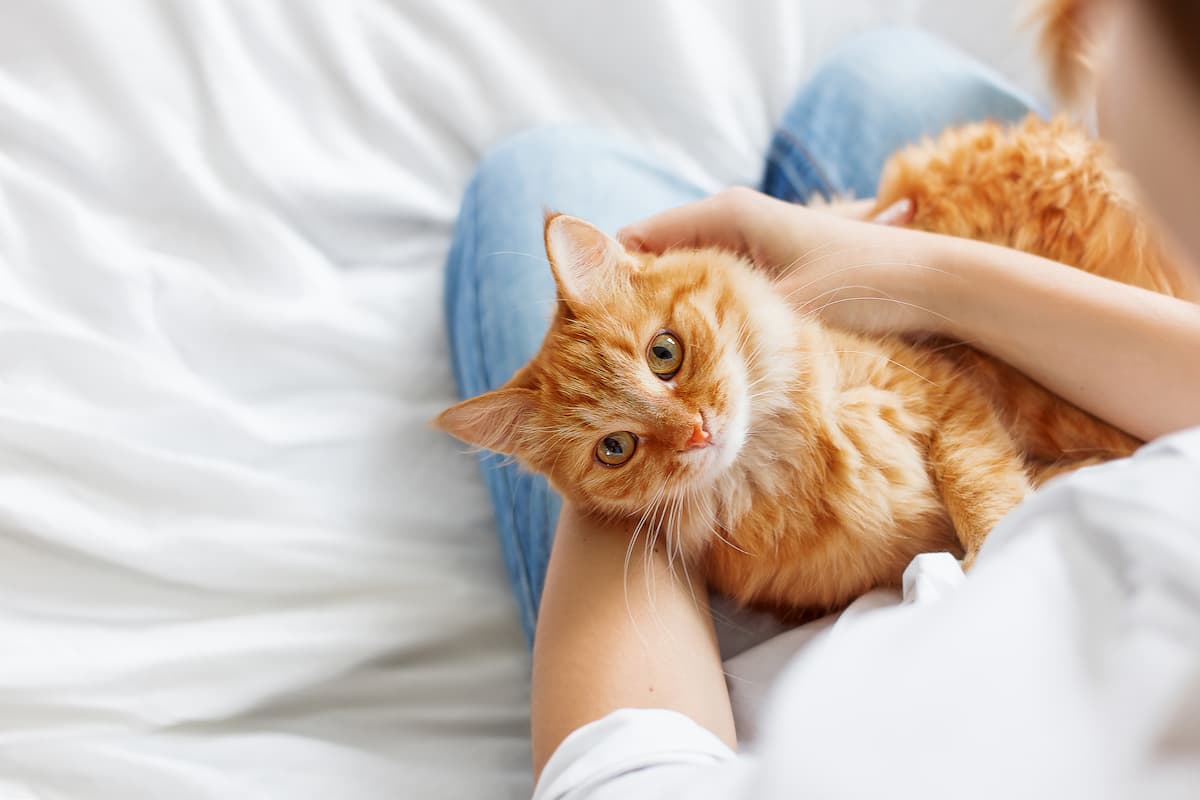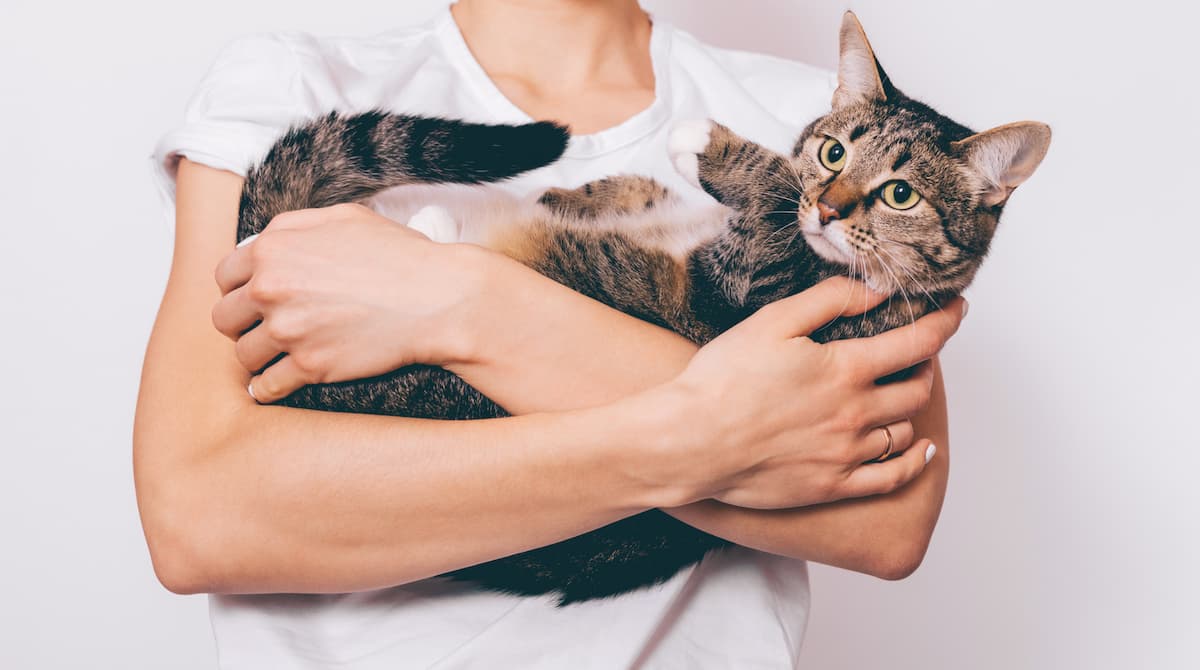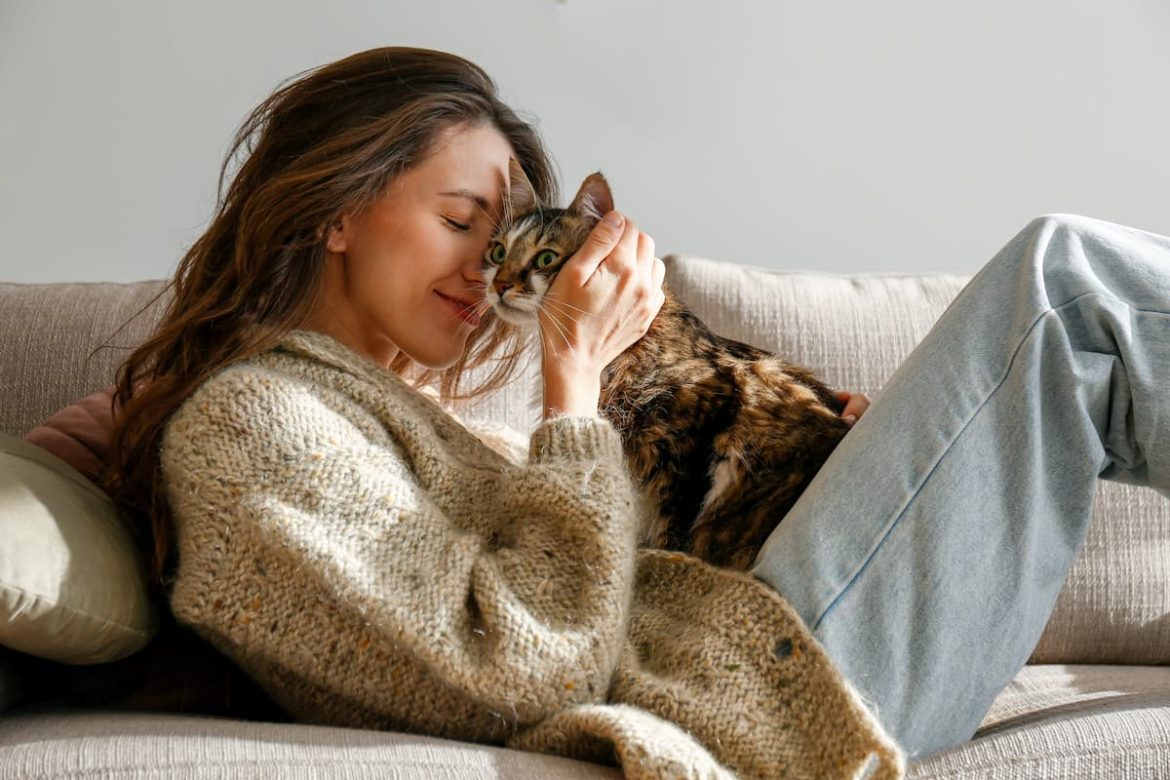Most cat parents will tell you that every day is Hug Your Cat Day, but 30th May marks the official Hug Your Cat Day and gives us even more excuses to shower our cats with love and affection. The question is, do they feel the same affection for us?
You’ll be happy to know that cats can form bonds and feel connection with their human carers. Today, we’ll explore your cat’s love language, their signs of affection for you, and how you can return the love.
 Firstly, do cats feel affection for humans?
Firstly, do cats feel affection for humans?
The short answer is yes; cats can feel affection for humans.
The longer answer starts around 10,000 years ago when we first started to domesticate cats, or rather, they began to domesticate us. The early human-feline relationship was based on mutual gain: cats wanted to eat the mice found around human settlements, and we were happy to have free pest control.
However, over the years, cats became more and more domesticated, eventually cohabiting with humans.
One reason people label cats as aloof is that they view feline behaviour through a canine lens. Dogs are—and always have been—social animals who live and hunt in packs, whereas cats are far more independent. So yes, they won’t jump up on you, wagging their tail when you arrive home from work, but they will show their affection more subtly.
This relatively recent shift in focus has been backed by scientific studies. One research paper documented that the attachment style of a cat and its human is similar to that of an infant and its parent. Another study examined social referencing, or looking to others to help regulate our own behaviours. This research suggested that around 80% of cats look to humans for social reference; they look to us for advice.
Animals can’t speak our language, so it isn’t easy to pinpoint precisely what emotions they do and do not feel. However, as any cat parent will confirm, cats can bond with humans and show affection to them. Here’s how they do it.
How do cats show affection?
Trilling or purring
One of the most common ways a cat expresses their love and enjoyment for being in your company is by purring. This gentle, vibrating noise shows that your cat feels safe and comfortable in your company.
Trilling – sometimes called chirping – is another vocalisation that cats use to signify their love for you. If you notice your cat making this high-pitched trilling noise when you’re around, know it’s their way of saying, “I love you.”
Meowing can be a loving way to communicate if you and your kitty are “having a conversation,” but often, a meow is your cat telling you they want something (probably food).
Cat rolls
A cat’s belly is one of its most vulnerable areas, so if they roll over and displays this area to you, it’s a sure sign that you have won their trust and affection. However, note that a belly display doesn’t necessarily mean your cat wants their belly rubbed. This area is a particularly sensitive part of their bodies, so some cats don’t like to be touched there.
Sometimes, cats walk up to you before throwing themselves on the ground and rolling around to expose their belly. This is their way of saying, “I love and trust you and I’d like some attention right now.”
Licks and love bites
Licking is a significant part of a cat’s socialisation. When young, a kitten’s mum uses licking to soothe and clean her babies. As they grow, cats use licking to socialise with one another and show affection, so if they lick you, it indicates that they view you as part of their family.
You might ask, “Why does my cat hug my arm and bite me?” Sometimes, cats will gently nibble you as they groom, which is another common sign of affection. This should not be confused with a bite, though—if a cat bites you during playtime or when you’re fussing them, it probably means they’re feeling overstimulated. If the ears are flattened, it’s a sign of aggression.
Body language
Felines don’t have the vocal capabilities to express their love through language; instead, they use body language to signal their affection. Here are some common ways your cat could be expressing their love:
Cats don’t wag their tails like dogs but they do use these limbs to express emotion. A tail pointed straight up, without bristling, shows that your cat is pleased to see you and would like to connect.
Sometimes, cats intertwine their tails to signify friendship. If they want to transfer this behaviour to humans, they will wrap their tail around part of your body, often the lower legs. This is their way of saying, “You are my friend.”
While shoving your butt in someone’s face might not be a stereotypical way to show your love, it is common in the feline world. So don’t be offended if your cat holds their rear end up to your face; it’s actually a sign of affection.
The look of love
When it comes to cats, the look of love is quite literal. If your cat looks at you with half-closed eyes and a slow blink, it is their direct way of saying, “I love you.”
During a first meeting, cats often stare with large, unblinking eyes or avoid making eye contact at all. So, if you get half-closed eyes or a slow blink, regard it as a huge compliment.
 Kneading you or rubbing against you
Kneading you or rubbing against you
“Making biscuits” or kneading is a common cat behaviour that signifies affection. It originates from a kitten kneading their mother to stimulate milk production. When kneading, your cat marks you via their scent glands.
As smell is a cat’s primary sense, this behaviour is an important part of socialisation as it helps them recognise other cats within their group. So, if your cat marks you with its scent, consider yourself part of their group. If your cat is fond of making biscuits while sitting on your lap, it shows that it is feeling loved and content.
It’s worth noting that cats sometimes use kneading to self-soothe. So, if you notice your cat is kneading excessively when lying alone or on a blanket, you might want to check if it is displaying any signs of anxiety.
Cats also achieve “marking” behaviour by rubbing themselves against part of your body—often the head or lower legs. When your cat rubs its head against you, it is demonstrating its love and affection.
Additionally, cats will sometimes give you gentle headbutts – a behaviour referred to as bunting – which is another way for them to mark their territory and express how much you mean to them. You may notice this behaviour around other pets as well as humans.
Gift giving
A dead mouse on the doorstep might not be an ideal start to the day, but hunting is a natural behaviour for a cat, and they shouldn’t be punished for engaging in it. If your cat brings you this type of “gift,” they want to show you how much they love you and how much you mean to them.
Indoor cats will opt for slightly less gruesome objects. They’ll most likely bring you one of their toys or “hunting objects” as a present. Be sure to thank them for their kind gesture; they’re trying to do something nice for you.
Subtle signs
While there are a bunch of affectionate displays cats use to tell you that they love you, there are a few more subtle ways that demonstrate your cat’s trust and affection for you:
If your cat wanders around and explores when you’re home, it’s a sign that they feel safe and secure. When a stranger comes into their environment, they can sometimes hide to avoid interaction with the unknown. When your cat feels comfortable enough to go about their daily business with you present, it’s a great sign of trust.
Following you around is another sign of affection. They’re following you because they like being close to you and are curious to see what you get up to. If your cat enjoys your company, talk to them; they may not understand what you are saying, but cats can tell when we are directing our speech to them – often because of our tone. (Some people think we sound silly using “baby voices” when talking to companion animals, but this change in pitch and tone can help them understand that we’re talking to them).
Another sign that your cat cares about you is if they greet you when you arrive home. Sitting at the door as you turn the key is their way of saying, “Welcome home, I’m happy to see you.”
Cats are most vulnerable when sleeping, so if they choose to sleep in your company or on your bed, it’s a sign that they feel safe around you. Curling up to sleep on you is the ultimate sign of bonding and trust between you and your cat.
 Give some love to your cat on ‘World Hug your Cat Day’
Give some love to your cat on ‘World Hug your Cat Day’
Now that you have some tools to decipher your cat’s love language, it’s time to return the favour and show them some appreciation. Here are some ideas for showing your cat how much you love them:
- Kitty kisses: when your cat does a slow blink, return the gesture by slowly closing your eyes halfway to say, “I love you too!”
- Be dependable: Cats love routine and reliability, so be there for them and provide a sense of safety in their environment. This routine should involve keeping your cat safe and secure when you’re away.
- Provide a comfortable environment: think cosy blankets, pet beds, scratching poles, cat towers, perches, and spaces to call their own.
- Play games: Cats – especially kittens and young adults – love playing games with their humans. Use wand toys, tunnels and interactive games to enrich their day. Did you know that you can train some cats to play fetch? Try throwing one of their “hunting toys” and see if you can get them to bring it back to you.
- Provide yummy foods: The way to a cat’s heart is through its belly. Providing them with a protein-rich, quality, well-balanced diet will keep them happy and healthy, and they will understand how much you care about them.
- Food enrichment: You can also incorporate puzzles or lick mats to make food time fun. You can even hide cat treats around their play area so that they can “hunt” for their food.
- Groom your cat: If your cat grooms you, return the favour by giving them a gentle brush or a massage. Not all cats enjoy this, but it’s the purrfect pampering treat for some.
- Quality time: Just give your cat time and attention. Even if it’s just Netflix and chill, your cat will still feel loved if the two of you are snuggled up together and they can relax.
Most importantly, experiment with different forms of communication and interaction to see how your cat responds and what they enjoy most. Take some time to get to know your cat, and the two of you will be able to express your affection for one another in no time!

